Angling Artist: Erik Schmidt
Erik Schmidt's ink work highlights the intersection of nautical body art with the American Traditional tattoo style.
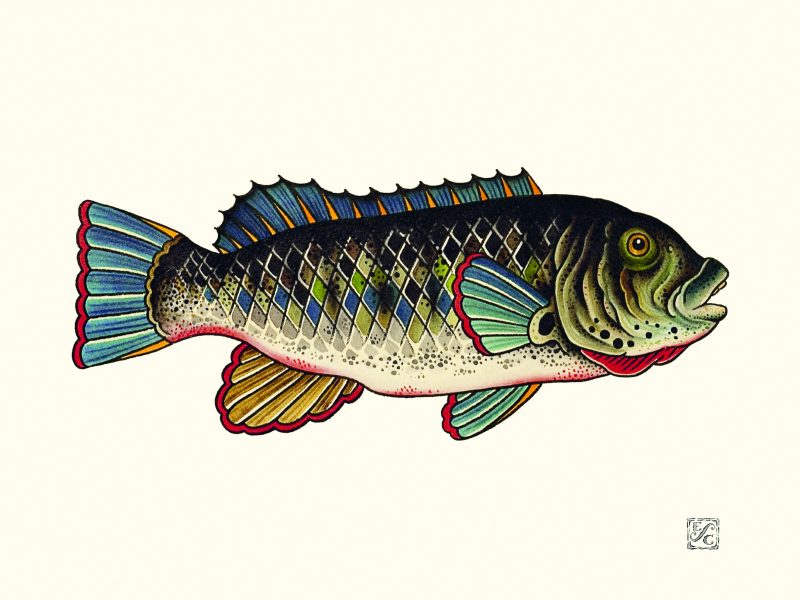
Tattoos and maritime culture have been close friends for centuries. George Greer, an American Union sailor during the Civil War, detailed his shipmates’ extensive ink in an 1862 letter:
“I wish you could see the bodies of some of these old saylors: they are regular picture books. [They] have ink pricked all over their body. One has a snake coiled around his leg, some have splendidly done pieces of Coats of Arms of states, American Flags, and most all have the Crusifiction of Christ on some part of their body.”
Over 160 years later, sailors, fishermen, and lovers of all things salty are still getting inked. Just one of the artists carrying on this centuries-old tradition is Erik Schmidt, a native Vermonter. While Vermont doesn’t possess an ounce of salt water, it is still home to a thriving artistic community. Erik attended school close to home at Johnson State College, where he studied art, a subject to which he’d always been attracted. One of the beauties of the college experience, though, is meeting people from unfamiliar places with different demeanors, and lifestyles. At Johnson State, Erik met tattooed classmates from other states such as New York and New Jersey. Tattoos, Erik says, were not very popular in Vermont at the time, but as an art student, he became fascinated with the unique artistic medium of ink on skin. As an undergrad, Erik began drawing images in the traditional American tattoo style to present to local tattoo shops. By 2005, he was off to Bradley Beach, New Jersey, a town of sun, sea, and lots of tattoos.
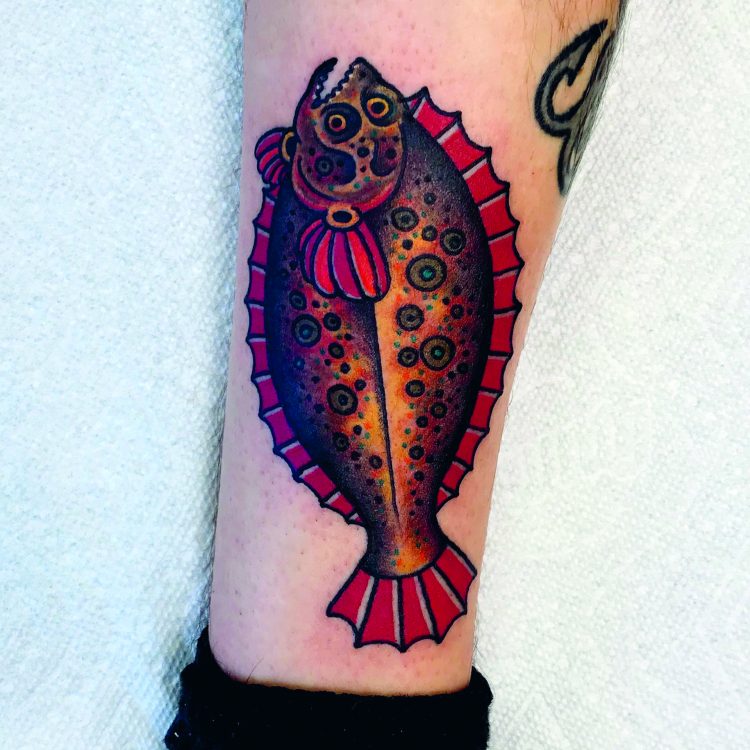
It took only one year in Bradley Beach before Erik began expressing his creative energy through tattooing. He started at Neptune Tattoo in 2006 and has been there ever since. While tattooing Jersey Shore locals, Erik became enthralled by certain images. Fishermen came in and got a tattoo of their favorite gamefish, while maritime men would ask for a lighthouse or an anchor. Regardless, all these clients wanted to memorialize their love for the sea, a fellow seaman, or a certain moment by the sea they didn’t ever want to forget. Erik’s aesthetic brain began to churn because he loved doing tattoos of marine life, especially for fishermen, “Fish are a crazy subject matter. They are beautiful, balanced images that you can be creative with.”
Erik applies the “American traditional tattoo style” in his work. This style is characterized by bold black outlines, a limited but bright color palette, and often a set of common motifs. “There are still designs that are classic and timeless” Erik says, “like a rose, a cross, or a bird.” It is incredible when considering the change in all the decades of American tattooing, technology, and cultural perception, that the main cast of images still evokes the sailor tattoos of tattooing’s early days.
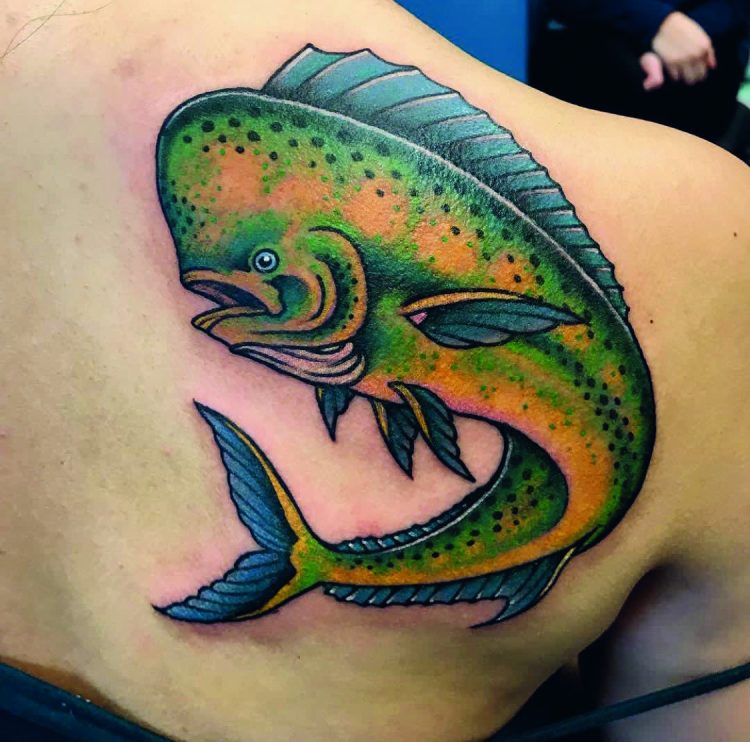
Erik expressed that “Tattoo culture is more prominent now; it is not as countercultural. It is more memorialization or storytelling on the body.” The clientele receiving tattoos is also changing rapidly, says Erik, “I have done a first tattoo on people 18 years old all the way to 75 years old.” It is this vast and diverse client base that aids Erik’s creativity.
For those who have never set foot in a tattoo parlor, the paper sketching of a tattoo in preproduction is called a “flash” and is done with pen and ink on paper. Erik’s prints, working backward, go from flash, to living tattoo, and back to paper again in his prints. Moving to paper prints affords Erik creative freedoms not available while inking a client’s body.
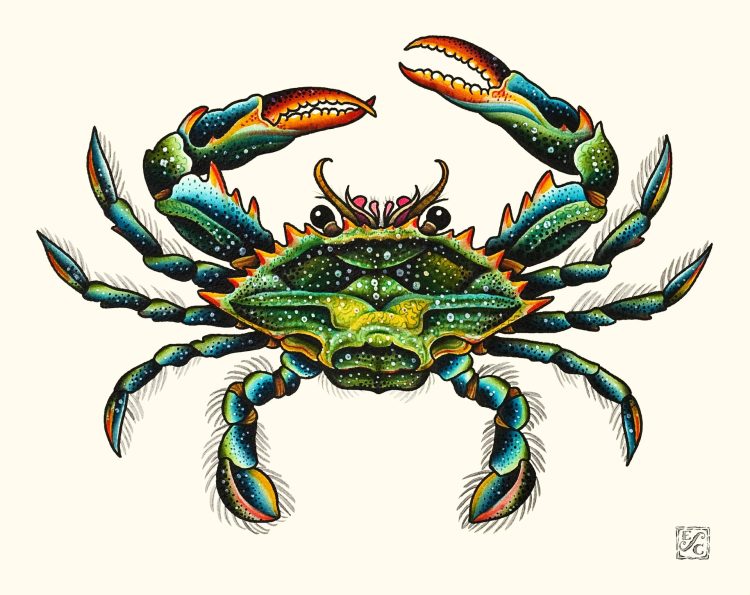
Prints are not limited by having to withstand fading or sticking to a limited color palette. Erik’s prints are done with ink and potent watercolor on sepia-colored paper, which he says helps him mimic the feeling of sketching on skin. Despite the extra freedoms that print affords a tattoo artist, Erik still keeps his style in line with traditional American tattoos. Prints are nice to line the walls of a living room or tattoo parlor, but Erik’s true love is still tattooing and the ever-potent tattoo community. Tattoo artists, tattoo recipients, and tattoo shops have a special bond over their shared passion, much in the same way tackle shops, fishermen, and boat captains share a love for the tug.
Erik has been with Neptune tattoo almost 20 years, which allows him a lot of freedom. “Clients seek out an artist based on his or her style, so the people who want a tattoo by me want something in the style I am comfortable with.” Clients seek out their artists based on tattoo style, and Erik’s personal style happens to attract the fish-mongering type, but it allows him to work according to his own aesthetic values. “I will sit down with a client and talk out ideas or references,” Erik states, “but, ultimately, it is put in my hands.”
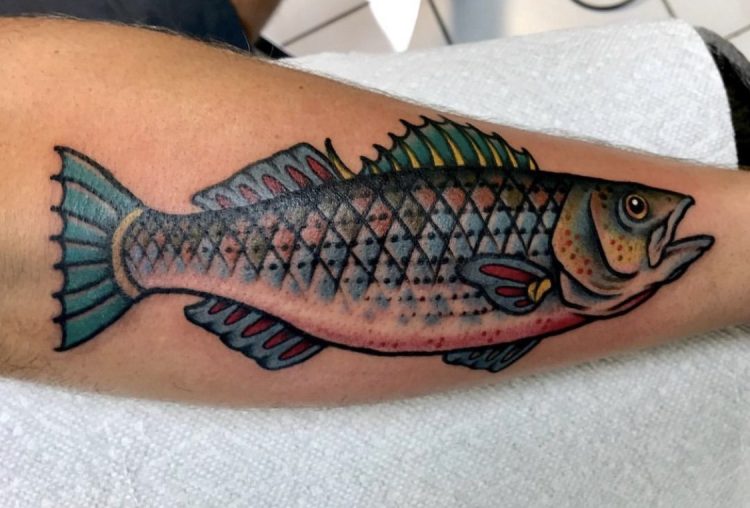
I can only imagine the feeling of strolling down the boardwalk and seeing a piece of my work living and breathing on the skin of another person. But for a tattoo artist, this is not an uncommon occurrence. Through his years of service in the Bradley Beach area, Erik has gotten to know the local community of striped bass fishermen. A fanbase staunchly loyal to their favorite fish, many of them get those seven stripes inked on them permanently. So, next time you land the catch of a lifetime, consider skipping the Instagram grip-and-grin and instead make an appointment at your local tattoo shop … if you’re brave enough.
1 thought on “Angling Artist: Erik Schmidt”
-
Bill Walsh How can you purchase a print. I’m interested in the totaug print
Leave a Reply